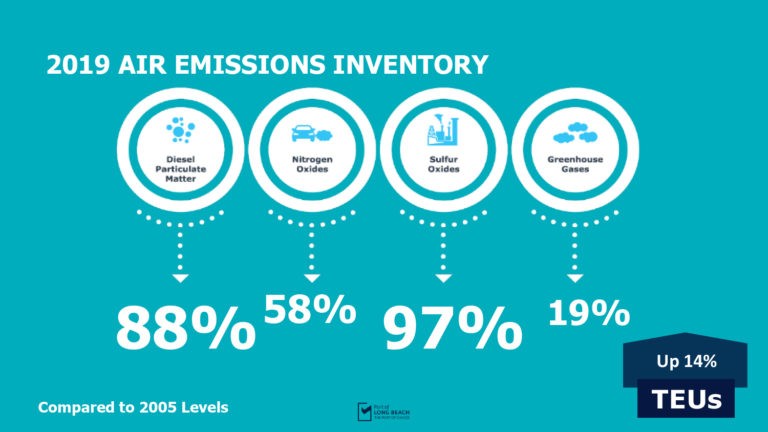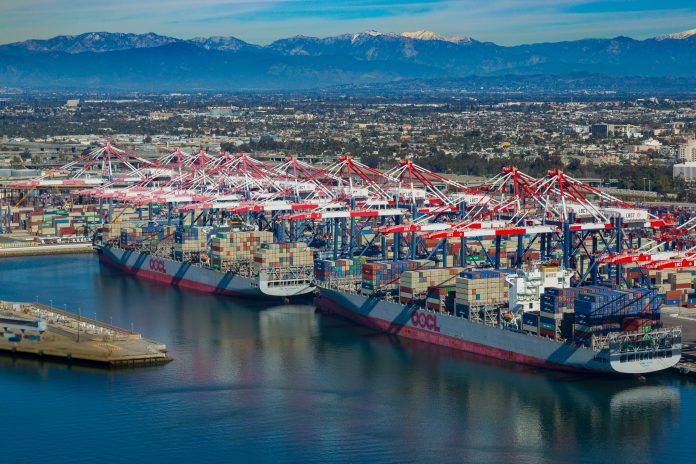California ports have seen a tremendous bimester with all-time container volume records breakings and significant progress in their environmental goals.
The Port of Los Angeles (POLA) marked the busiest September in its 114-year history, processing 883,625TEU, which translates to a 13.3% increase compared to the same month of 2019.
At the same time, the last quarter has become the all-time best quarter at the port with 2,701,847TEU handled at Los Angeles during the third quarter of 2020.
A sign that shows that the Covid-19 crisis is not depressing port volumes at POLA is the fact that no sailings have been cancelled during September, when 97 cargo vessels arrived at the port.
“Despite unresolved questions about our nation’s health, economy and export strength, imports have improved significantly after a difficult spring,” said POLA executive director, Gene Seroka.
September loaded imports increased by 17.3% to 471,795TEU compared to the previous year, while loaded exports decreased by 0.3% to 130,397TEU and empty containers increased by 14% to 281,434TEUs. The total throughput eclipsed the previous September record set in 2018. Additionally, year to date cargo has decreased by 8.9% compared to 2019.
Meanwhile, the Port of Oakland has also celebrated its best September ever in terms of import cargo volume. The port saw 93,916TEU full import containers last month, surpassing the previous 2019 record.
The Port attributed the boost in imports to US retailers stocking up in preparation for the traditional holiday shopping season. Consumer products combined with pandemic-related items such as personal protective supplies helped make September a record-breaking month, according to a port announcement.
“As retailers make sure shelves are well-stocked, we’re waiting to see if consumers begin shopping early this holiday season,” commented Port of Oakland maritime director, Bryan Brandes.
The port noted that containerised import volume jumped 10.6% in September compared to 2019, while exports were also up 5% compared to the same period last year. Total box throughput for the previous month increased by 9.3% compared to 2019 September.
The surge in California port volumes could be attributed to retailers hedging against another possible Covid wave this winter, according to the port, as retailers appear to be building their stocks as they continue to see the spread of more factory closures and lockdowns.
Compared to last year, this year’s first nine months show full imports gaining a marginal 0.4% and full exports falling by 0.2% at the Port of Oakland.
Moreover, the Port of Long Beach (POLB) has not reported its September results yet, but August was the best in its 109-year history, achieving volumes of 725,610TEU, which is a 9.3% growth compared to the same month in 2019.
Mario Cordero, POLB executive director, remains vigilant about the global pandemic’s lasting effects, stating that “Despite the recent surge in cargo, uncertainty remains in international trade and the national economy, given the ongoing Covid-19 impacts.”
The boost was at the start of the peak shipping season, which typically runs from August to October as retailers prepare for the upcoming holiday shopping season. In August, demand for such goods as home improvement items and home exercise equipment contributed to the increase in shipments, according to an announcement, along with another short-term increase in extra vessel visits that made up for voyages that were cancelled earlier this year.
The Port has moved 4,911,725TEU during the first eight months of 2020, which translates to a 1.2% decrease from the same period in 2019.
In the meantime, both Oakland and Los Angeles ports have reported cargo surges in August with the Port of Oakland announcing a 9% jump in imports and a 1.4% increase in exports compared to August 2019, while POLA marked its first monthly cargo increase in the year, achieving a 12% gain, driven by imports.
Simultaneously, POLB and POLA have both announced an important improvement in their clean air projects.
According to a newly completed study of air pollution at the Port of Long Beach, diesel particulates have decreased by 88%, sulphur oxides are down 97%, while smog-forming nitrogen oxides have decreased 58%. At the same time, greenhouse gas emissions reductions were 19%, according to the study.

The pollution levels are all compared to the 2005 baseline, the year before the original San Pedro Bay Clean Air Action Plan (CAAP) was adopted.
The Port’s annual emissions inventory report, presented to the Long Beach Board of Harbor Commissioners in September, shows the Californian port continued to demonstrate low levels of emissions for diesel particulates and sulphur oxides in 2019 despite the growth of 14% in the containerised cargo at the Port of Long Beach since 2005.
According to the Port of Los Angeles new 2019 Inventory of Air Emissions report, POLA and its partners succeeded in cutting emissions between 5% and 7% compared with 2018.
In 2019, the Port either maintained or exceeded its best numbers since the 2005 baseline year for reducing ground-level pollutants associated with health risk and respiratory illness, according to an announcement.
Emissions of nitrogen oxides (NOx) are down 62%, the largest drop in NOx from port-related activity since 2005, while sulphur oxides (SOx) and diesel particulate matter (DPM) remain down 98% and 87%, respectively, since 2005.
On a per-container basis, the port’s 2019 clean air progress was even more noteworthy with POLA making headway in almost every category, including greenhouse gases (GHGs) associated with climate change, which, reported in carbon dioxide equivalents (CO2e), are down 32% for every 10,000TEU since 2005. The only exception was SOx, which remains down 98% on a per-container basis since 2014.
“We can’t defeat the climate crisis until we put the brakes on dangerous emissions — and our Port is an essential anchor in our efforts to forge a more sustainable future,” said Los Angeles Mayor, Eric Garcetti.







